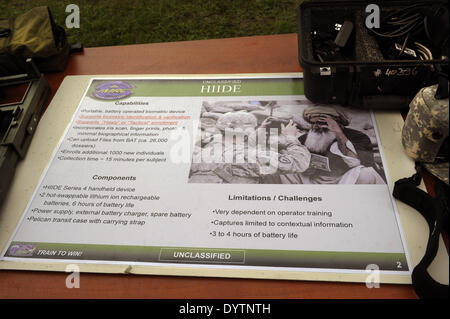

These include facial features, voice patterns, fingerprints or iris features. Building biometric databases Biometric data, or simply biometrics, are unique physical or behavioural characteristics that can be used to identify a person. This development is the latest in many incidents that exemplify why governments and international organizations cannot yet securely collect and use biometric data in conflict zones and in their crisis responses. Military equipment and devices including the collected data are speculated to have been captured by the Taliban, who have taken over Afghanistan. Today, HIIDE provides access to a database of biometric and biographic data, including of those who aided coalition forces. Over time, for the sake of efficiency, the system came to include the data of Afghans assisting the US during the war. The device, known as Handheld Interagency Identity Detection Equipment (HIIDE), was initially developed by the US government as a means to locate insurgents and other wanted individuals. "We don't have a complete picture, obviously, of where every article of defence materials has gone but certainly, a fair amount of it has fallen into the hands of the Taliban, and obviously, we don't have a sense that they are going to readily hand it over to us at the airport," said the NSA.Toronto: In 2007, the United States military began using a small, handheld device to collect and match the iris, fingerprint and facial scans of over 1.5 million Afghans against a database of biometric data. Sullivan further said that a significant quantity of the US weapons given to Afghanistan is believed to be in the hands of the Taliban, and the Biden administration does not expect them to be returned to the US.

National Security Advisor (NSA) Jake Sullivan on Tuesday said that the White House does not believe the Taliban will return US weapons captured from Afghan forces.

There is a history of ISI collaboration with the Taliban. “The Taliban doesn’t have the gear to use the data but the ISI do,” said the former Special Operations official while referring to Inter-Services Intelligence (ISI), the Pakistani spy agency. "(HIIDE) was used as a biometric ID tool to help ID locals working for the coalition," The Intercept cited an unnamed US official as saying.Īn Army Special Operations veteran pointed out that HIIDE data can be difficult to process for the Taliban, but noted that Pakistan may provide additional help to the group. "We processed thousands of locals a day, had to ID, sweep for suicide vests, weapons, intel gathering, etc." said a US military contractor. Taliban might use these data to track down and target innocent Afghans. The HIIDE devices store biometric data, such as fingerprints and iris scans, as well as biographical information. There is no information on how much of the US military's biometric database on the Afghan population was compromised.Īdditionally, the devices hold biometric data of those Afghans who aided the US during the war. Three ex-US military personnel and an official from the Joint Special Operations Command are concerned that the Taliban could access the sensitive information.


 0 kommentar(er)
0 kommentar(er)
